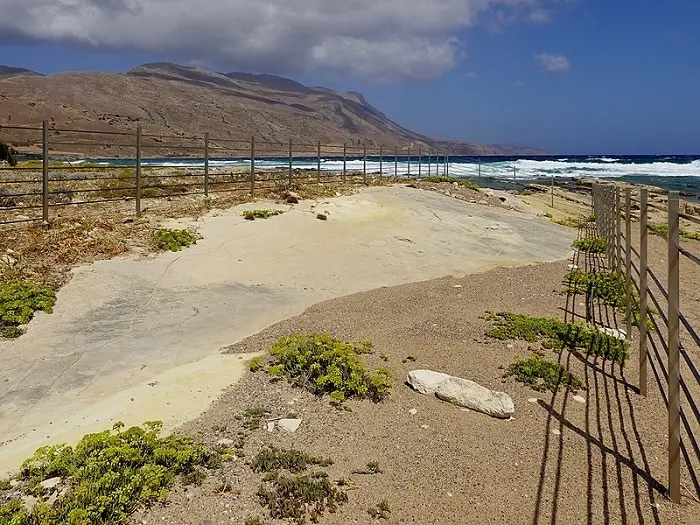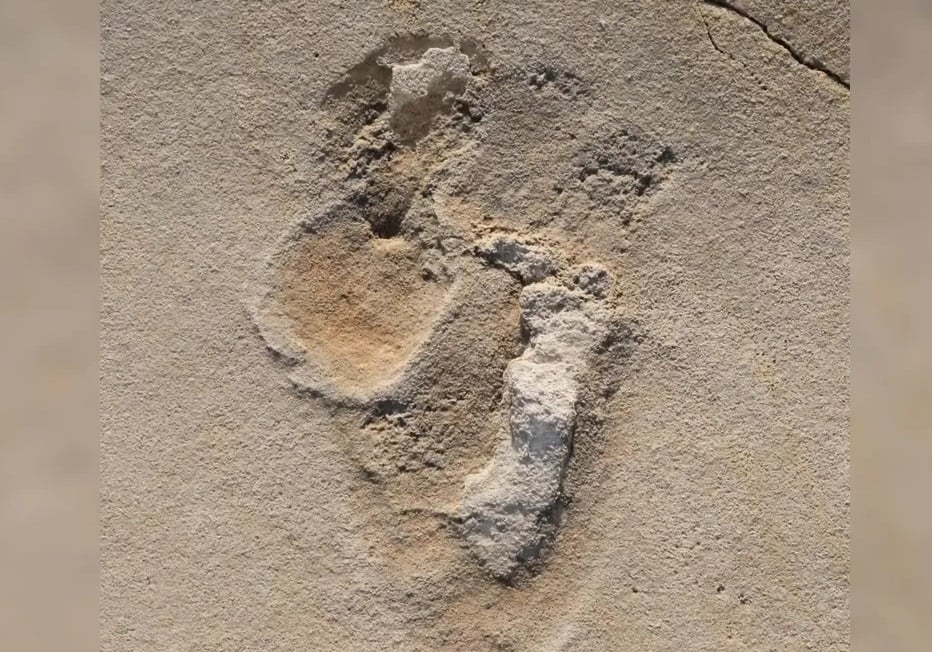
He was not looking for hominid footprints from the prehistoric past. Paleontologist Gerhard Gierlinski, from Warsaw, Poland, was just trying to get away from it all in the summer of 2002 and enjoy the warm seas and soft sands on the Greek island of Crete with his girlfriend.
A researcher at the Polish Geological Institute, he was always ready to take samples of interesting things he spied on vacations, and he traveled with a hammer, a camera and a GPS for just such occasions.
What he discovered along the Mediterranean shores of the town of Trachilos would rock his world and send some researchers who were convinced that humans evolved solely in Africa, into angry denial, resulting in many of them casting aspersions on his jaw-dropping find.
Gierlinski asked colleagues from Poland, Sweden, Greece, the US and the UK, among them Dr. Per Ahlberg, for their opinions on what he saw as human-like footprints that had somehow been made into a flat rock along the shore.
The team of experts concluded that indeed, the impressions had been made by ancient human ancestors 5.6 million years ago, making them by far the oldest footprints ever discovered in Europe.
Recent research shows that the 50 footprints are more than 300,000 years older than previously thought, according to a scientific paper published in Scientific Reports.

Earliest known hominid footprints in the world
They had been made during the Miocene era, at a time when the entire Mediterranean Sea had dried up. The scientific world was faced with the notion that these small footprints on the Greek island would now be the earliest-known human-like prints in the world — far older than the prints previously found in Africa, from Laetoli in Ethiopia, which were made 3.66 million years ago on a volcanic deposit there.
Ahlberg, from Sweden’s Uppsala University, and his colleague Matthew Robert Bennett, from Bournemouth University in the UK, took on the unenviable task of putting their names on the scientific paper that would be published regarding the discovery of the footprints.
Six and a half years of “living hell”
Later, Ahlberg would describe what happened later as “six and a half years of sort of a living hell.” Their paper, published in the Proceedings of the Geologist Association, may be read by clicking here.
In a recent interview with Greek Reporter, Ahlberg was asked if there has been any further feedback — or blowback — since the 2017 publishing of the article, and if this discovery has been deliberately ignored and shunted aside since it may be politically incorrect or go against the “Africanist” theory of human origin.

“The short answer is that there has not been much of a response at all from the mainstream palaeoanthropological community.
“Of course, you can never really know what goes on in the heads of other scientists, but I do rather think the story has been deliberately ignored because it doesn’t fit the prevailing narrative,” the member of the Swedish Academy of Sciences replies.
However, one key group of researchers, the scientist told Greek Reporter, have not ignored the startling findings of 2002.
“Shortly after publication, we made contact with Madelaine Böhme’s group at Tübingen and her colleagues in Bulgaria and Canada, who have been working on the scarce and fragmentary body fossil record of European Miocene hominins.
“The key animal on that side is Graecopithecus, known from a single lower jaw found near Athens and a tooth plus some other bits and pieces from Bulgaria.
“It is similar in age to the Trachilos footprints, perhaps marginally older. As you might guess, the Böhme team had great difficulty getting their work published as well, and met the same kind of hostility as we did.”
These researchers were very impressed with the Trachilos team’s groundbreaking findings, and friendships were quickly established among the scientists.
Miocene-era ape lived in present-day Bulgaria
“Recently we met up in Crete to film material for a major TV documentary dealing with the emerging evidence for an early presence of hominins in Europe, and also to take samples for palaeomagnetic dating and detrital zircon dating of the Trachilos locality,” Ahlberg recalls.
“The present dating, based on microfossils called foraminifera, is robust but not terribly precise; we would like to be able to narrow it down.
“We had intended to move forward fairly quickly with follow-up papers describing the footprints in more detail and establishing the date more precisely, but various things got in the way.
Madelaine and her team have been focused on new excavations and new discoveries from Bavaria (Danuvius guggenmosi, a Miocene ape very close to the common ancestor of hominins and chimpanzees) and Bulgaria – and then the coronavirus pandemic came along. So everything is kind of in stasis right now, but we do intend to pick up the story again,” Ahlberg adds.
“Doing sound and exciting science”
Asked if the scientist’s all-important funding had been affected by the controversial nature of the findings, he answers in the negative. “My funders (the Knut & Alice Wallenberg Foundation) are entirely happy that I am doing sound and exciting science, and so they keep supporting me.
“Also… most of my research does not deal with early hominins but with other long-ago things such as the origin of jawed vertebrates and the transition from fish to land animals. In these areas, I’m one of the world-leading researchers.”
In his original article, Ahlberg stated “it is now for the researchers in the field to embark on finding more tracks.” As it turns out, no additional discoveries of footprints have been made in this area since that time.
Pursuing new ape and hominid footprints and fossils
As to why not, the researcher answers “I can’t tell you; you would have to ask those people why they have made their particular decisions. However, the Böhme team is very active in their pursuit of new ape and hominin body fossils from the Miocene of Europe, so that’s certainly moving the story forward.”
Since Ahlberg had stated in his earlier paper, published in The Conversation “the very essence of science is prospection, discovery, evidence-based inference and debate,” Greek Reporter asked him how scientific progress can occur if these things are shut down.
Voices for hominin origin in Europe “getting louder”
“Well,” the researcher answered, “the obvious answer is that it can’t. However, in the area of early hominins, things aren’t quite as bad as that. The voices arguing for a hominin presence, and perhaps origin, in the Miocene of Europe are getting louder.
“A particularly important milestone in this regard was the publication of the Danuvius paper, not in some minor journal, but in Nature.
“Similarly, Böhme team member David Begun, who’s based in Toronto, has written a quite authoritative book about the Miocene apes of Europe called, delightfully, “The Real Planet of the Apes.” This is getting quite a lot of attention. So while there are still plenty of people who are not listening, and who no doubt would like us to just shut up and go away, the debate is not in fact being shut down.”
“There are always people who are open-minded and curious enough to allow new perspectives to break through — though often only after a long struggle. What is more of a concern is whether research funding in some areas is becoming strongly tied to adherence to particular paradigms because that kind of thing can stifle innovation.
“I have been extremely fortunate in having sufficient freely disposable funding to pursue ideas I’m interested in, even if they are unpopular with some.”
See all the latest news from Greece and the world at Greekreporter.com. Contact our newsroom to report an update or send your story, photos and videos. Follow GR on Google News and subscribe here to our daily email!



